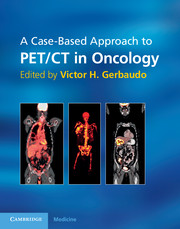Book contents
- Frontmatter
- Contents
- Contributors
- Foreword
- Preface
- Part I General concepts of PET and PET/CT imaging
- Part II Oncologic applications
- Chapter 5 Brain
- Chapter 6 Head, neck, and thyroid
- Chapter 7 Lung and pleura
- Chapter 8 Esophagus
- Chapter 9 Gastrointestinal tract
- Chapter 10 Pancreas and liver
- Chapter 11 Breast
- Chapter 12 Cervix, uterus, and ovary
- Chapter 13 Lymphoma
- Chapter 14 Melanoma
- Chapter 15 Bone
- Chapter 16 Pediatric oncology
- Chapter 17 Malignancy of unknown origin
- Chapter 18 Sarcoma
- Chapter 19 Methodological aspects of therapeutic response evaluation with FDG-PET
- Chapter 20 FDG-PET/CT-guided interventional procedures in oncologic diagnosis
- Index
- References
Chapter 13 - Lymphoma
from Part II - Oncologic applications
Published online by Cambridge University Press: 05 September 2012
- Frontmatter
- Contents
- Contributors
- Foreword
- Preface
- Part I General concepts of PET and PET/CT imaging
- Part II Oncologic applications
- Chapter 5 Brain
- Chapter 6 Head, neck, and thyroid
- Chapter 7 Lung and pleura
- Chapter 8 Esophagus
- Chapter 9 Gastrointestinal tract
- Chapter 10 Pancreas and liver
- Chapter 11 Breast
- Chapter 12 Cervix, uterus, and ovary
- Chapter 13 Lymphoma
- Chapter 14 Melanoma
- Chapter 15 Bone
- Chapter 16 Pediatric oncology
- Chapter 17 Malignancy of unknown origin
- Chapter 18 Sarcoma
- Chapter 19 Methodological aspects of therapeutic response evaluation with FDG-PET
- Chapter 20 FDG-PET/CT-guided interventional procedures in oncologic diagnosis
- Index
- References
Summary
Introduction
Hodgkin's (HL) and aggressive non-Hodgkin's lymphomas (NHL) are potentially curable neoplasms owing to their marked chemo- and radiosensitivity as well as to recent introduction of more effective treatment strategies (1, 2). In these patients individualized therapy schemes based on well-defined risk categories can be devised with the prerequisite of an accurate staging system for evaluation of disease extent. Accurate risk profiling based on staging and established predictors of outcome as well as effective response evaluation during or following therapy and restaging are essential to determine the optimal treatment strategies. Anatomic imaging modalities, including both computed tomography (CT) and magnetic resonance imaging (MRI) cannot differentiate between active lymphoma and a benign process or inflammation-induced reactive changes in relatively small lymph node groups.
The increasing availability of positron emission tomography using 18F-fluorodeoxyglucose, particularly fused with computed tomography (FDG-PET/CT) has lead to the integration of this modality into the routine staging and restaging algorithms for lymphoma, providing comprehensive information about tumor glucose metabolism combined with anatomic data. The metabolic information can potentially impact patient management and survival, if decisions about additional therapy or to make a change in treatment regimen could be reliably based on FDG-PET imaging. There is now convincing evidence that FDG-PET is a more accurate imaging modality in the staging and evaluation of treatment response of lymphomas compared with conventional imaging techniques, including CT. Furthermore, persistent FDG uptake during and after chemotherapy has high sensitivity and specificity to differentiate residual viable disease from inflammatory post-therapy changes.
- Type
- Chapter
- Information
- A Case-Based Approach to PET/CT in Oncology , pp. 329 - 365Publisher: Cambridge University PressPrint publication year: 2012

